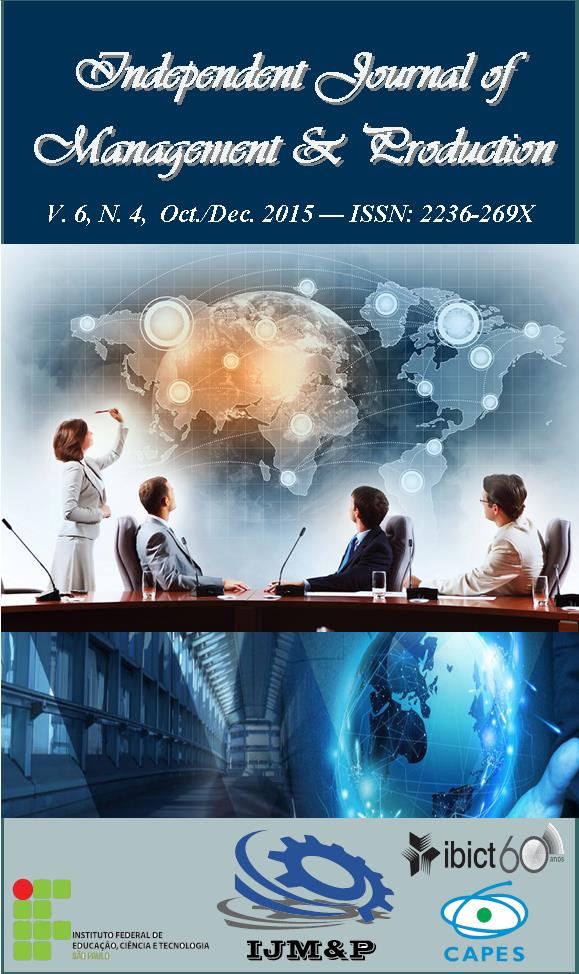Proximity as a key factor to narrow the relationship between supplier and its customer – a case study in the auto industry
Main Article Content
صندلی اداریAbstract
Downloads
Article Details
1. Proposal of Policy for Free Access Periodics
Authors whom publish in this magazine should agree to the following terms:
a. Authors should keep the copyrights and grant to the magazine the right of the first publication, with the work simultaneously permitted under the Creative Commons Attribution-NonCommercial-ShareAlike 4.0 that allows the sharing of the work with recognition of the authorship of the work and initial publication in this magazine.
b. Authors should have authorization for assuming additional contracts separately, for non-exclusive distribution of the version of the work published in this magazine (e.g.: to publish in an institutional repository or as book chapter), with recognition of authorship and initial publication in this magazine.
c. Authors should have permission and should be stimulated to publish and to distribute its work online (e.g.: in institutional repositories or its personal page) to any point before or during the publishing process, since this can generate productive alterations, as well as increasing the impact and the citation of the published work (See The Effect of Free Access).
Proposal of Policy for Periodic that offer Postponed Free Access
Authors whom publish in this magazine should agree to the following terms:
a. Authors should keep the copyrights and grant to the magazine the right of the first publication, with the work simultaneously permitted under the Creative Commons Attribution-NonCommercial-ShareAlike 4.0 [SPECIFY TIME HERE] after the publication, allowing the sharing of the work with recognition of the authorship of the work and initial publication in this magazine.
b. Authors should have authorization for assuming additional contracts separately, for non-exclusive distribution of the version of the work published in this magazine (e.g.: to publish in institutional repository or as book chapter), with recognition of authorship and initial publication in this magazine.
c. Authors should have permission and should be stimulated to publish and to distribute its work online (e.g.: in institutional repositories or its personal page) to any point before or during the publishing process, since this can generate productive alterations, as well as increasing the impact and the citation of the published work (See The Effect of Free Access).
d. They allow some kind of open dissemination. Authors can disseminate their articles in open access, but with specific conditions imposed by the editor that are related to:
Version of the article that can be deposited in the repository:
Pre-print: before being reviewed by pairs.
Post-print: once reviewed by pairs, which can be:
The version of the author that has been accepted for publication.
The editor's version, that is, the article published in the magazine.
At which point the article can be made accessible in an open manner: before it is published in the magazine, immediately afterwards or if a period of seizure is required, which can range from six months to several years.
Where to leave open: on the author's personal web page, only departmental websites, the repository of the institution, the file of the research funding agency, among others.
References
AYMARD, P.; BRITO, E. (2009) Custos de mudança em serviços logísticos. Gestão e Produção, v. 16, n. 3, p. 466-478.
BENNETT, D.; KLUG, F. (2012) Logistics supplier integration in the automotive industry. International Journal of Operations & Production Management, v. 32, n. 11, p. 1281-1305.
CORRÊA, H. L.; GIANESI, G. N. (2012) Just in time, MRP II e OPT: um enfoque estratégico. São Paulo: Atlas.
GEBENNINI, E.; GAMBERINI, Y.; MANZINI, R. (2009) An integrated production-distribution model for the dynamic location and allocation problem with safety stock optimization. International Journal Production Economics, v. 122, p. 286-304.
GUARNIERI, P.; HATAKEYAMA, K. (2010) Formalização da logística de suprimentos: caso das montadoras e fornecedores da indústria automotiva brasileira. Produção, v. 20, n. 2, p. 186-199.
LEE, J.; LEE, Y. (2012) Facility location and scale decision problem with customer preference. Computers & Industrial Engineering, v. 63, p. 184-191.
MARCONI, M. A.; LAKATOS, E. M. (2010) Fundamentos de metodologia científica, 7th ed. São Paulo: Atlas.
MESQUITA, M.; CASTRO, R. (2008) Análise das práticas de planejamento e controle da produção em fornecedores da cadeia automotiva brasileira. Gestão e Produção, v. 15, n. 1, p. 33-42.
OMAR, M.; SARKER, R; OTHMAN, W. (2012) A just in time three level integrated manufacturing system for linearly time varying demand process. Applied Mathematical Modelling, v. 37, p. 1275-1281.
PACHECO, D.; JUNIOR, A.; ROCHA, E.; DORNELLES, P. (2012) Uma investigação sobre as implicações da logística enxuta: uma análise das percepções de clientes e fornecedores. In: ENEGEP – ENCONTRO NACIONAL DE ENGENHARIA DE PRODUÇÃO, 32, Bento Gonçalves, Proceedings... Rio de Janeiro: ABEPRO, 2012.
PATTON, M. Q. (1990) Qualitative evaluation and research methods. Newbury Park, CA: Sage.
REGO, J.; MESQUITA, M. (2011) Controle de estoque de peças de reposição: uma revisão da literatura. Produção, v. 21, n. 4, p. 645-655.
SALERMO, M. S. et al. (2001) Mapeamento da nova configuração da cadeia automotiva brasileira. Departamento de Engenharia de Produção da Escola Politécnica da Universidade de São Paulo. São Paulo: EDUSP.
SANTORO, M.; FREIRE, G. (2008) Análise comparativa entre modelos de estoques. Produção, v. 18, n. 1, p. 89-98.
TONTINI, G.; ZANCHETT, R. (2010) Atributos de satisfação e lealdade em serviços logísticos. Gestão e Produção, v. 17, n. 4, p. 801-816.
VANALLE, R. M.; SALLES, J. A. A. (2011) Relação entre montadoras e fornecedores: modelos teóricos e estudos de caso na indústria automobilística brasileira. Gestão e Produção, v. 18, n. 2, p. 237-250.
YIN, R. K. (2009) Case study research: design and methods, 4th ed. Newbury Park, CA: Sage.





